Caridina shrimps are a type of vibrant dwarf freshwater shrimps originating from tropical and subtropical regions of Asia, Oceania, and Africa. This shrimp is line bred to multiple morphs and is widely available in most pet stores and online.
In this article, we will discuss everything you need to know about Caridina shrimps.
- Caridina Overview
- Types of Caridina Shrimps
- How long do caridina shrimps live?
- How big do caridina shrimps get?
- Behavior and Temperament
- Caridina shrimps care requirements
- What to feed Caridina Shrimps?
- Do caridina shrimps need Calcium?
- Is it easy to breed caridina shrimps?
- Mixing Caridina shrimps with other species
- Conclusion
Caridina Overview
Caridina Shrimps are a group of shrimps belonging to the Atyidae family of shrimps. These shrimps are very sought after by hobbyists for their unique patterns and coloration. The word “Caridina” is the name given to a genus of freshwater shrimps. Many of the shrimps available in the aquarium trade are in the caridina genus but have their own name and their special care needs.
Caridina Shrimp are not beginner-level shrimp, to keep these guys healthy you need to have some experience. If you have never kept shrimps before, we recommend starting with Caridina shrimps as they are hardy and relatively cheaper to purchase.
The shrimps available in the pet stores are selectively bred by aquarists’ for their color and patterns. Crystal Shrimps, Bee Shrimps, and Tiger Shrimps are the most available types of Caridina shrimps in the hobby. The words “crystal”, “bee”, and “tiger” represent the pattern that the shrimp possess and they each come in different color morphs. The shrimp pattern and the colors define the grade of the shrimp.
Types of Caridina Shrimps
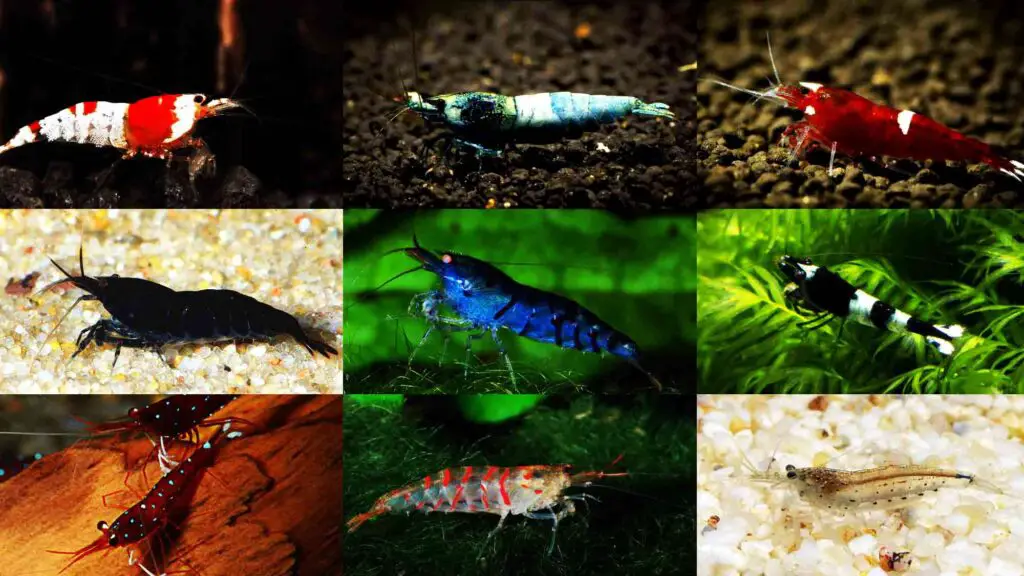
Currently, there are more than 280 different species of Caridina Shrimps scientifically described but not all of them are available in pet stores as pets you can purchase. Depending on the type of shrimp, they can range from 0.5 inches to 4 inches in body length.
They come in different sizes, shapes, and colors that might not look similar to each other at all. Of the 280+ types of caridina, there are a few of them that are very famous and available in pet stores. Generally, Caridina Shrimps need similar care requirements but there are types that need completely different care requirements.
Here are our top picks for the most beautiful and famous types of caridina shrimps:
Amano Shrimp
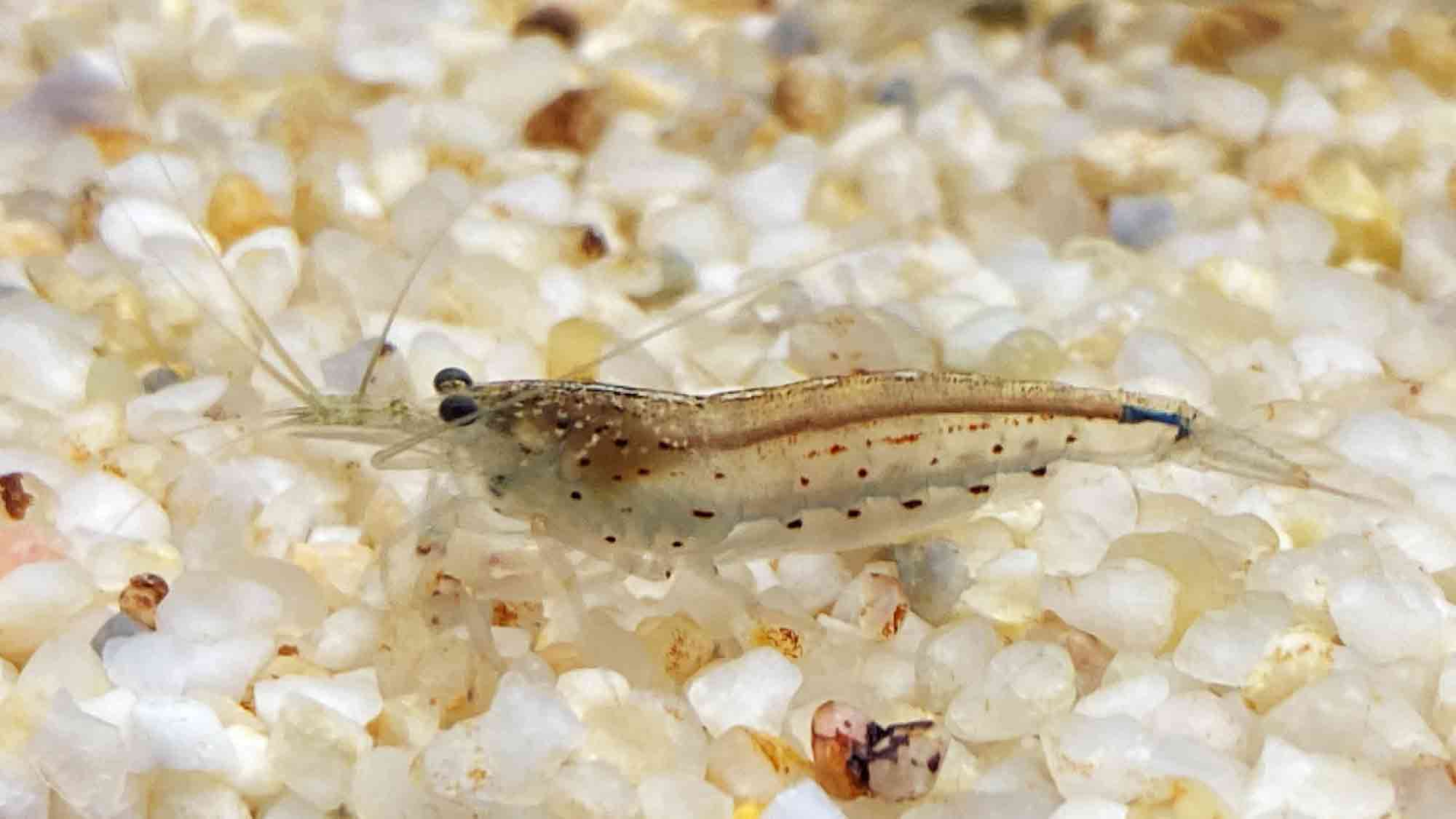
Caridina multidentata or more commonly known as Amano shrimp is a small species of Caridina. They gained popularity after Takashi Amano used them in his tanks, this is why they are called “Amano” shrimps. They are native to Japan and Taiwan and are also known by other names like Yamato shrimp, Japanese shrimp, Amano shrimp, and algae shrimp. Learn more about Amano Shrimp.
Crystal Red Shrimp
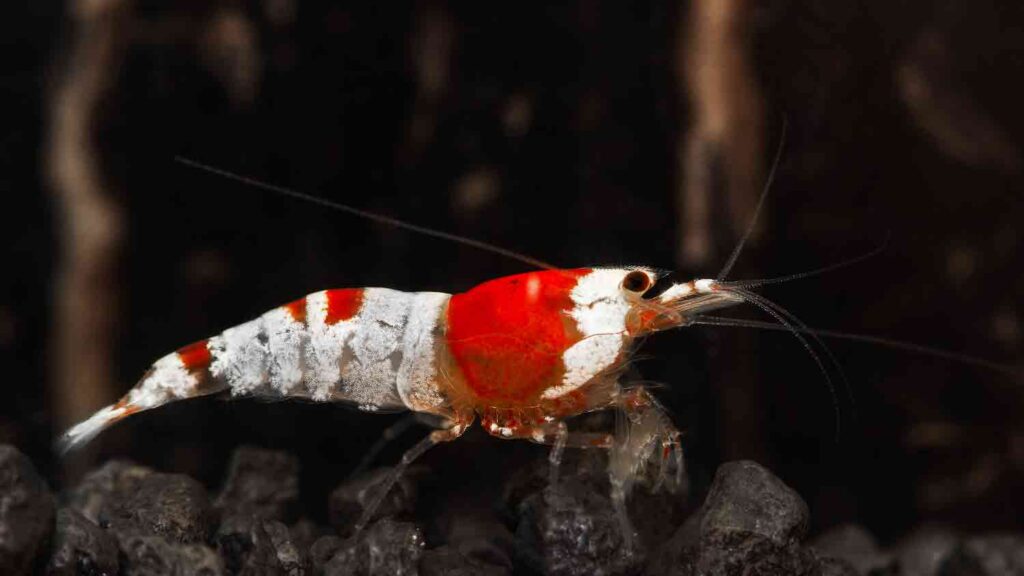
Crystal Red Shrimps are beautiful types of caridina and are a variant of Bee Shrimps (Caridina cantonensis). Scientifically they are known as Caridina cantonensis var. ‘Crystal Red’.
This species is very famous for its beautiful red and white colors that will pop out in any tank. This variety of bee shrimps was the first line bred in Japan and after winning a lot of shrimp awards it spread to other parts of the world.
Cardinal Sulawesi Shrimp
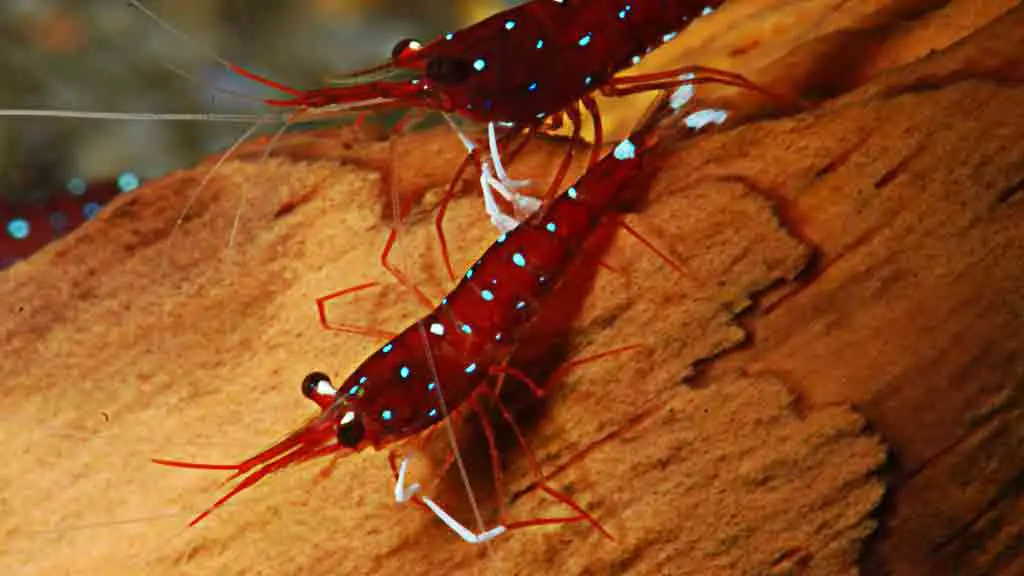
Cardinal Sulawesi Shrimp is a beautiful type of caridina shrimp that are native to the Sulawesi in Indonesia. These shrimps are slightly easier to keep compared to other types of caridina shrimps but they are definitely not beginner friendly like neocaridina.
These shrimps are beautifully painted in red and sprinkled with white dots. This gives them a very different look than other types of shrimp in the hobby. Because of their beautiful colorations, they are in high demand but since they are coming from two tiny lakes in Indonesia the supply is limited.
Blue Tiger Shrimp
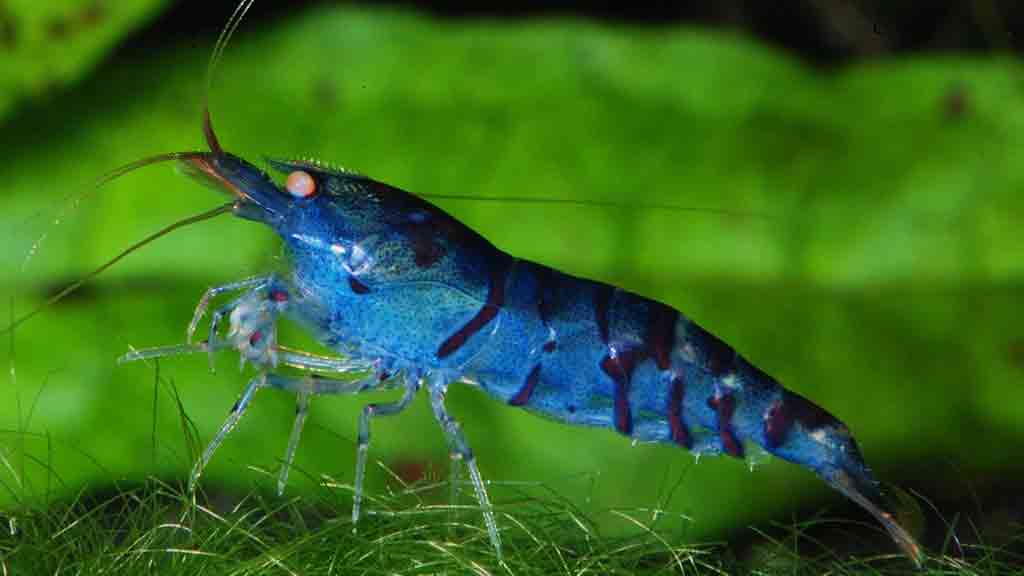
Blue tiger shrimps are covered in a dark blue color and have black stripes that run across their body. These black stripes give them the look of a tiger and that is why they are called blue tiger shrimps. They are also known for their bright orange eyes that are very visible to the naked eye.
They are one of the harder types of caridina to breed pure. Not all shrimps in a batch will become and look like tigers. This makes them rare and a little expensive. When they are young they do not show their true coloration and you have to wait until they mature to be able to see the true patterns and coloration of each snail.
Black Tiger Shrimp
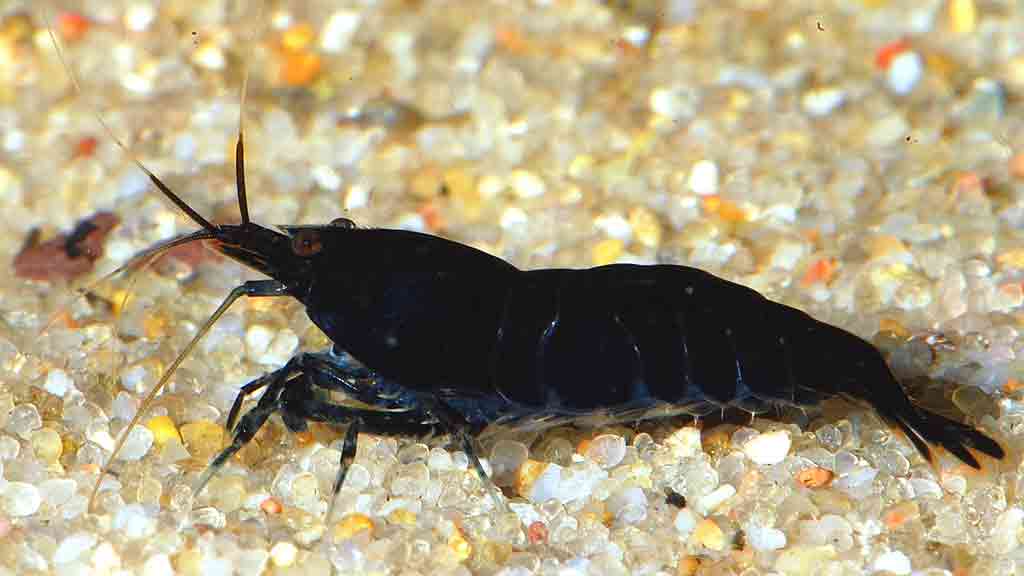
Black Tiger Shrimp (Caridina cf. cantonensis var. ‘black tiger’) is a type of caridina that originates in Taiwan. They are the black version of the Orange Eye Blue Tiger and share a lot of similarities in care and appearance.
They come in different shades of black and the darker they are the more expensive they become. Same as Blue Tigers they have bright orange eyes that shine in the darkness of their body color.
Red Tiger Shrimp
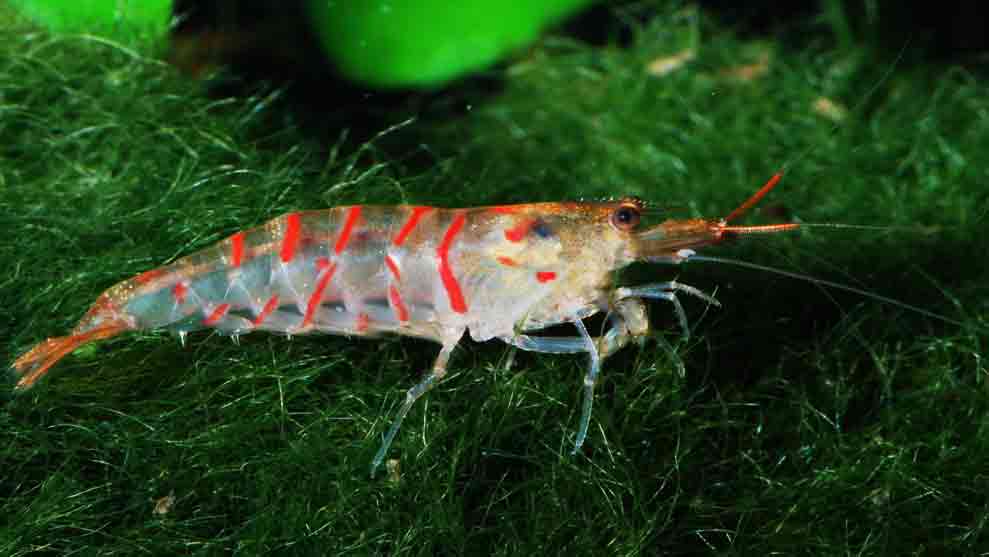
The Red Tiger Shrimp (Caridina cf. cantonensis var. ‘red tiger’) is a stunning variety of Caridina that has red stripes on its translucent body. As the name suggests these shrimps are painted in red tiger-like stripes that make them look extremely beautiful. They’re one of the harder types of shrimps to keep so only expert shrimp keepers should try to keep and breed them. Unlike other types of tiger shrimps, these guys have dark eye colorations.
Blue Bolt Shrimp
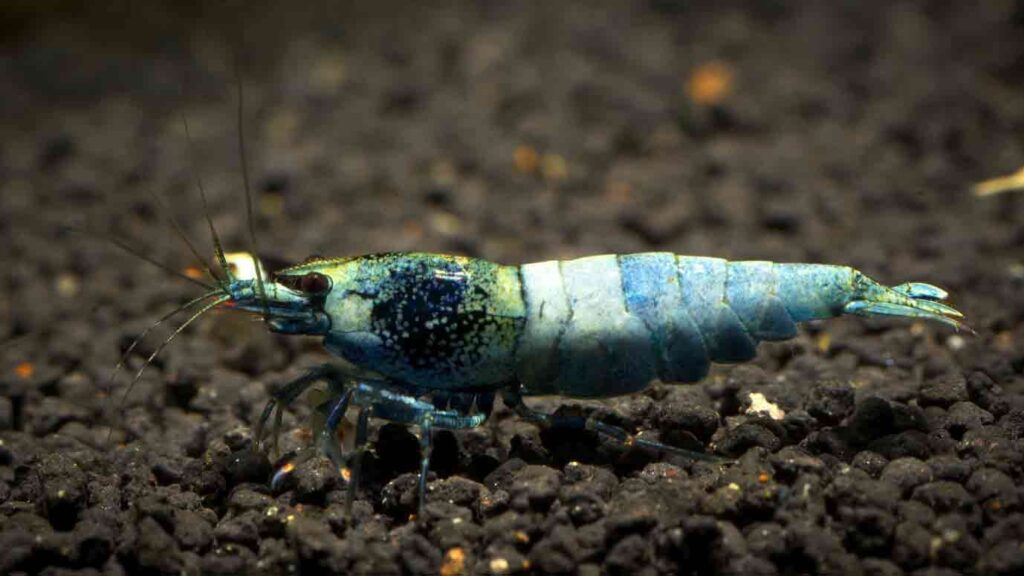
Blue bolt shrimp (Caridina cf. cantonensis var. ‘blue bolt’) are a variety of bee shrimp. These shrimps are similar to the Crystal red shrimp and need similar care requirements. Blue bolt, like other caridina shrimps, needs clean and RO water to be able to live and breed. This makes it somewhat hard to keep so you should only attempt to keep them if you have experience with shrimps and can provide the right environment for your shrimp. They are very fussy and demanding shrimps and a small mistake can kill an entire colony of blue bolts.
Black Bee Shrimp
Black Bee Shrimp (Caridina cf. cantonensis var. ‘black bee’) are a small and beautiful type of caridina that can live in a small tank. These sensitive and fragile shrimps need specific water conditions to be able to live so they are definitely not beginner shrimp.
These fun-to-watch shrimps love to hide and enjoy their time in peace. This means they need a lot of plants and decorations to be able to live comfortably. Keeping a colony of black bee shrimps can be rewarding if you have experience with caridina.
Red Ruby Shrimp
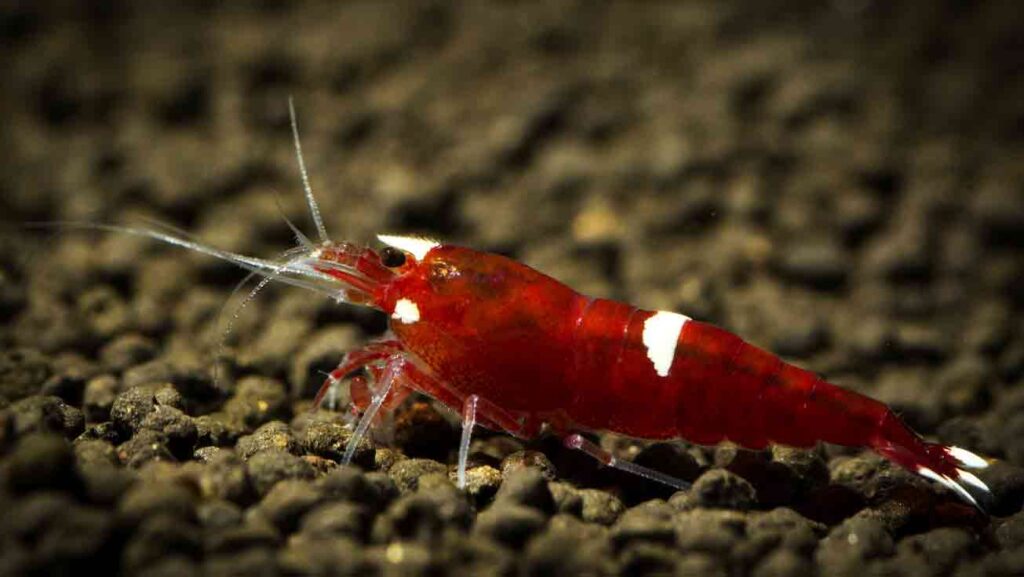
Red Ruby Shrimp (Caridina cf. cantonensis var. ‘red ruby’) is a variant of caridina shrimp that are not very common in the shrimp-keeping world. This variant belongs to the bee shrimps and develops a beautiful red color with one or two patches of white on their body. They are a very fragile type of shrimp and need the same care requirements as Crystal red shrimps.
Panda Shrimp
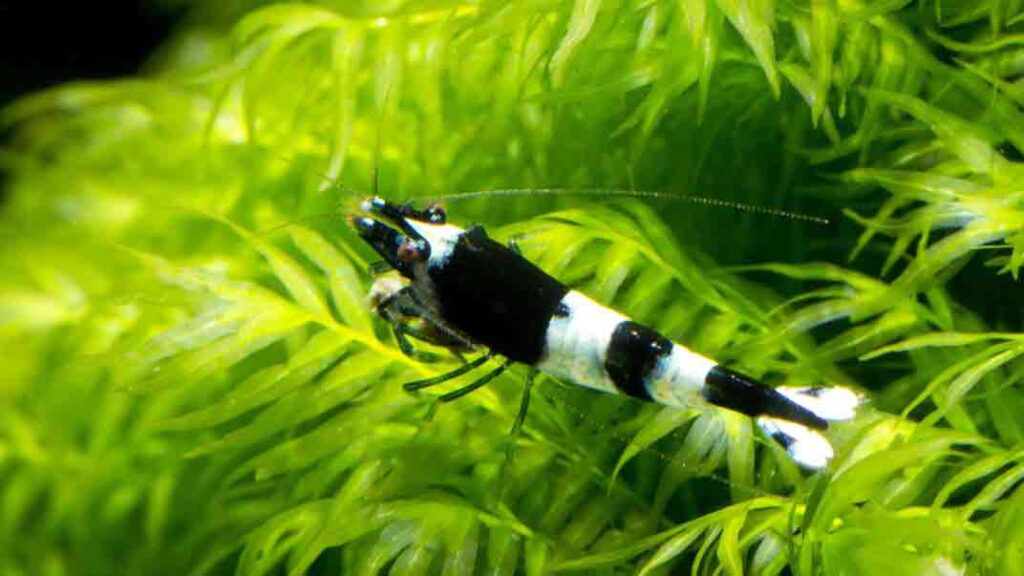
Panda Shrimp (Caridina cf. cantonensis var. ‘panda’) are a variety of Taiwanese Bee shrimp. They are the black and white mutation of crystal red shrimp and share the same care requirements. The Panda shrimp, as the name suggests, develops beautiful and thick stripes and patches of black and white on its body that resemble a panda. This variant of bee shrimps is very fragile and super sensitive to changes in water parameters.
How long do caridina shrimps live?
The Caridina Shrimps that are available in the hobby will only live for about 1 – 2 years. Under optimal water parameters with a balanced diet, they will easily reach and might even surpass the two years. They grow relatively fast and in just a few months they will become fully mature adults. During this process, shrimps continuously molt their shell and with each molt, they grow bigger.
They may not have a long life, but their rapid growth and breeding will keep up with the die-off in your colony. Due to this, they are easy species to keep and breed when conditions are right.
How big do caridina shrimps get?
The Caridina shrimps available in pet stores are usually small variants and will grow to about 1 – 4 inches in length. The majority of types of caridina shrimps available in pet stores will only grow to 1 inch. A few of the Caridina shrimps can grow to 2-4 inches in length.
Female Caridina Shrimps tend to grow bigger and more plump compared to males. This is because the females are responsible for carrying the eggs.
Behavior and Temperament
Caridina Shrimps are not aggressive species, they are a peaceful and calm cleaning crew of nature. They’ll keep the same personality traits and job when they come to your tank. Same as in the wild, they will constantly keep themselves busy eating biofilms or any other food available. This is why most aquarists use them as their cleaning crew in their nano or peaceful community tank.
They also eat nematodes, rotifers, tardigrades, ciliates, and any similar microorganisms that can live in a fish tank.
Caridina shrimps care requirements
Compared to other types of shrimps these guys are a little difficult to care for, That’s because they need very specific water parameter requirements to thrive. However, this doesn’t mean it’s not possible or they are the hardest pets to have in the aquarium hobby. When you follow the information in this article you will find it very easy to care for your Caridina shrimp.
When tank setup is done right, these shrimps are one of the most low-maintenance aquarium pets available in the hobby. These shrimps do well in a tank with tropical and clean water conditions, but some might need different parameters.
Water current and movement are other important things to watch for. Caridina shrimp are coming from very slow-moving streams and ponds, they do not like fast-moving water.
Keep in mind that copper is extremely toxic to caridina shrimps and should be avoided at all costs. You will need to make sure your decorations, substrate, food, and medications are copper free.
Unlike fish, shrimp are designed to be the cleaning crew of nature that will not produce a lot of waste. As a result, a smaller tank can house a large colony of shrimps. That said, for larger species of caridina, you will need to make sure you are not overcrowding your tank.
As a starting point, you can house a small colony of these shrimps in a 10-gallon tank. For larger species, you will need to either keep a smaller number of them or simply get a bigger tank. Larger tanks are always better options for shrimps as the water parameters stay much more balanced in larger aquariums.
Shrimps will mainly walk on the surfaces in the tank and feed on the algae and biofilm grown on these surfaces. Therefore it’s crucial to provide them with as much surface area as possible in their tank. You can create a surface in the tank by adding live aquarium plants, decorations, and driftwood to your tank. These decorations will also aid in maintaining stability in your tank’s parameters.
What to feed Caridina Shrimps?
Quality food is essential for the health and coloration and proper development of your shrimp. There are many shrimp-specific foods available in the market that are designed specifically for Caridina shrimps. These foods are made for the specific needs of Caridina shrimps and will provide all the elements they need in their diet.
However, Caridina Shrimps will eat anything you give them. The food you give them has a direct impact on their breeding and healthy growth. When feeding fish food that is not designed for shrimps, make sure to check the ingredients for copper. Small amounts of copper can kill an entire shrimp colony.
Do caridina shrimps need Calcium?
Caridina shrimps, like all other shrimps, have a hard protective shell around their body. Their shell is made of calcium and they constantly molt. This makes it crucial for these shrimps to receive calcium in their diet. Younger shrimps molt even faster as they grow, and need more calcium to molt easily.
There are multiple brands making calcium supplements specifically for caridina shrimps. These products are a bit pricey but they contain all the elements your shrimps need. However, you can also feed your shrimp crushed egg shells as a budget-friendly option. Egg shells are made of calcium, and are great to feed your shrimps.
Is it easy to breed caridina shrimps?
To breed caridina shrimps you will need to recreate the exact water parameters your caridina shrimp needs. Depending on the types of caridina shrimp you have you might slightly need to change the parameters.
Once the parameters of the tank are in favor of your shrimp the females will call males to mate by releasing hormones in the water. The breeding cycle also depends on the type of caridina shrimp you have. But they are closely related and similar.
Mixing Caridina shrimps with other species
Caridina shrimp are small creatures with no defense mechanism. This makes them an easy meal for larger fish. These shrimps should not be kept in with any fish in order to maintain a growing population in your tank.
At the same time, most of the caridina shrimps will interbreed with each other. So if you want to keep your shrimp line pure, you should not mix them with other species in the caridina family. Mixing different types of caridina together can result in ugly-looking shrimp in your tank.
You can, however, mix Neocaridina Shrimps with caridina shrimps. These shrimps belong to a different genus and will not mate with each other. The only thing you need to make sure of is to set your water parameters in favor of caridina shrimps so both types of shrimps can thrive.
You can also keep your Caridina Shrimps with peaceful and herbivore plecos. Both plecos and Caridina Shrimps need softer water so they can be good companions. However, plecos produce a lot of waste and you might need to do more water changes.
Conclusion
Caridina shrimps are extremely vibrant and beautiful pet shrimps that are slightly difficult to keep. They are not beginner-level shrimps as the care requirements are different. These shrimps are sensitive to changes in the tank so advanced aquarists should try to keep them.
Credits: images have been cropped and color corrected to match the theme of this website.
Crystal Red Image:Dack9, CC BY 4.0
Cardinal Sulawesi, Blue Tiger, Black Tiger, Red Tiger Images:DirkBlankenhaus, CC BY-SA 3.0
Blue Bolt, Red Ruby, Panda Images:Marcus Hafermann, CC BY-SA 3.0